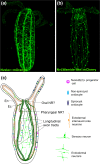The rise of the starlet sea anemone Nematostella vectensis as a model system to investigate development and regeneration
- PMID: 26894563
- PMCID: PMC5067631
- DOI: 10.1002/wdev.222
The rise of the starlet sea anemone Nematostella vectensis as a model system to investigate development and regeneration
Abstract
Reverse genetics and next-generation sequencing unlocked a new era in biology. It is now possible to identify an animal(s) with the unique biology most relevant to a particular question and rapidly generate tools to functionally dissect that biology. This review highlights the rise of one such novel model system, the starlet sea anemone Nematostella vectensis. Nematostella is a cnidarian (corals, jellyfish, hydras, sea anemones, etc.) animal that was originally targeted by EvoDevo researchers looking to identify a cnidarian animal to which the development of bilaterians (insects, worms, echinoderms, vertebrates, mollusks, etc.) could be compared. Studies in Nematostella have accomplished this goal and informed our understanding of the evolution of key bilaterian features. However, Nematostella is now going beyond its intended utility with potential as a model to better understand other areas such as regenerative biology, EcoDevo, or stress response. This review intends to highlight key EvoDevo insights from Nematostella that guide our understanding about the evolution of axial patterning mechanisms, mesoderm, and nervous systems in bilaterians, as well as to discuss briefly the potential of Nematostella as a model to better understand the relationship between development and regeneration. Lastly, the sum of research to date in Nematostella has generated a variety of tools that aided the rise of Nematostella to a viable model system. We provide a catalogue of current resources and techniques available to facilitate investigators interested in incorporating Nematostella into their research. WIREs Dev Biol 2016, 5:408-428. doi: 10.1002/wdev.222 For further resources related to this article, please visit the WIREs website.
© 2016 The Authors. WIREs Developmental Biology published by Wiley Periodicals, Inc.
Figures







References
FURTHER READING
References
-
- Dunn CW, Hejnol A, Matus MQ, Pang K, Browne WE, Smith SA, Seaver E, Rouse GW, Obst M. Broad phylogenomic sampling improves resolution of the animal tree of life. Nature 2008, 452:745–749. - PubMed
-
- Hand C, Uhlinger KR. The culture, sexual and asexual reproduction, and growth of the sea anemone Nematostella vectensis . Biol Bull 1992, 182:169–176. - PubMed
-
- Houliston E, Momose T, Manuel M. Clytia hemisphaerica: a jellyfish cousin joins the laboratory. Trends Genet 2015, 26:159–167. - PubMed
Publication types
MeSH terms
Grants and funding
LinkOut - more resources
Full Text Sources
Other Literature Sources

